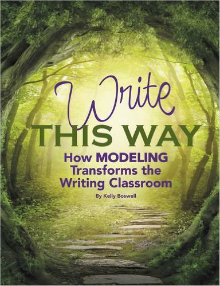Modeling Transforms the Writing Classroom
Write This Way: How Modeling Transforms The Writing Classroom
By Kelly Boswell
(Maupin House Publishing / Capstone Professional, 2015 – Learn more)

I was anxious to read Kelly Boswell’s Write This Way: How Modeling Transforms the Writing Classroom after attending one of her sessions at the Virginia State Reading Association’s annual conference in the spring of 2015. Ms. Boswell was an engaging speaker who provided practical advice on teaching writing and her book did not disappoint me.

What you’ll find inside
Write This Way is a teacher-friendly guide to implementing modeling as an essential component of daily writing instruction. I appreciated how modeling was addressed as a fundamental part of each step of the writing process. I also was pleased that the discussion of modeling was not limited to one type of text. Boswell demonstrates many variations.
The book is well organized; topics addressed include planning mini-lessons, providing feedback and conferencing, targeting skills, and using mentor texts, all while providing students with models of writing. Tables are used as effective methods for sharing information throughout the text and drawing the reader’s attention to specific ideas.
Boswell includes dialogue throughout the text, transporting the reader into her classroom while also reinforcing key points. These snippets of conversation further enhance her messages about teaching writing and reinforce the idea that reading this book is like having a conversation with the author.
Sample lessons, grouped by K-1, 2-3, and 4-5 levels, along with a variety of planning templates, allow teachers to try out Boswell’s ideas immediately and facilitate implementation. The lesson format is consistent across the grades, which supports incorporating these strategies vertically in a school. Furthermore, the lessons promote “a single, specific, and narrow focus” (Boswell, 2015, p. 90).
One of the best pieces of advice shared in this book is the reminder that teachers should not attempt to accomplish everything in one lesson, but need to be selective when planning lessons. Although the sample lessons are geared toward use in the elementary grades, adaptations could be made for use in higher grades.
Sorting out the terms we use
I appreciated how Boswell clarifies terms related to writing instruction that are sometimes confused or used interchangeably. For example, the differences between modeling, interactive writing, and shared writing are explained early in the book. And the author does not simply tell readers that the three kinds of writing are different; she illustrates exactly how each type of writing differs and provides a detailed table that offers a helpful visual for understanding both the differences between modeling, interactive writing and shared writing, and the roles of the teacher and students during each process.
Samples of teacher talk about each type of writing provide a catalyst for further dialogue with students. Boswell also devotes an entire chapter to identifying the differences between modeling and explaining. Again, she not only describes how the two actions differ, but she also includes another table that summarizes the main concepts in a reader-friendly way and provides a quick reference for future use.
Looking beyond modeling
Throughout the book Boswell includes guidance about aspects of writing instruction that are not strictly related to modeling but encompass other important areas of the writing process that will benefit all teachers.
For instance, when describing how she approaches commenting on student work, she reminds readers that comments can be either “constructive” or “destructive” as well as “specific” or “vague.” She encourages teachers to consider the words they use with students during writing instruction and explains how she uses the visuals of bricks and bulldozers when discussing writing with students.
I picture my words as either a brick or a bulldozer. The words I say, the feedback I give, can either build up a writer (brick) or tear him down (bulldozer).” (Boswell, 2015, p. 29).
These suggestions are valuable reminders for any writing teacher, regardless of the number of years in the classroom.
Boswell’s references are impressive and incorporate a variety of well-known authors from the field of writing instruction. Lucy Calkins, Ralph Fletcher, Donald Graves, William Zinsser, Kelly Gallagher, and Penny Kittle are only a few of the authors cited.
In addition, Boswell also includes links to research in comprehension and cognitive apprenticeship. She has grounded all of her ideas about modeled writing within a strong theoretical framework. The quotes that she places at the beginning of each chapter also remind readers of the wise words of key individuals who are respected in the field of writing.
The author anticipates our questions
Reading this book is like sitting down and having a conversation with Boswell because she anticipates and answers the questions that teachers will have about modeling. As a former classroom teacher, she recognizes and appreciates that modeling is a challenging part of teaching writing and can seem intimidating.
Her credibility is further enhanced by the description of her own evolution as a writing teacher. She is comfortable discussing the teaching issues that she has struggled with over the years, and her candid attitude is appealing. The chapter in which Boswell recounts what it was like to be a beginning teacher who did not know how to teach writing is a story that many teachers will appreciate.
Boswell has written a book that is a valuable resource for all teachers, whether they are new to the profession or established educators. Write This Way: How Modeling Transforms The Writing Classroom is a reference to keep close when planning writing instruction.
Jennifer Floyd is a K-5 reading specialist at Mountain View Elementary School, located in Buena Vista, Virginia. Jennifer is also a doctoral student in reading education at the University of Virginia and is active in the Shenandoah Valley Reading Council as a member of the board of directors. She is interested in using technology to enhance literacy instruction and parent involvement. Jennifer blogs at wahooliteracyteacher and is also on Twitter @jen4literacy.






























